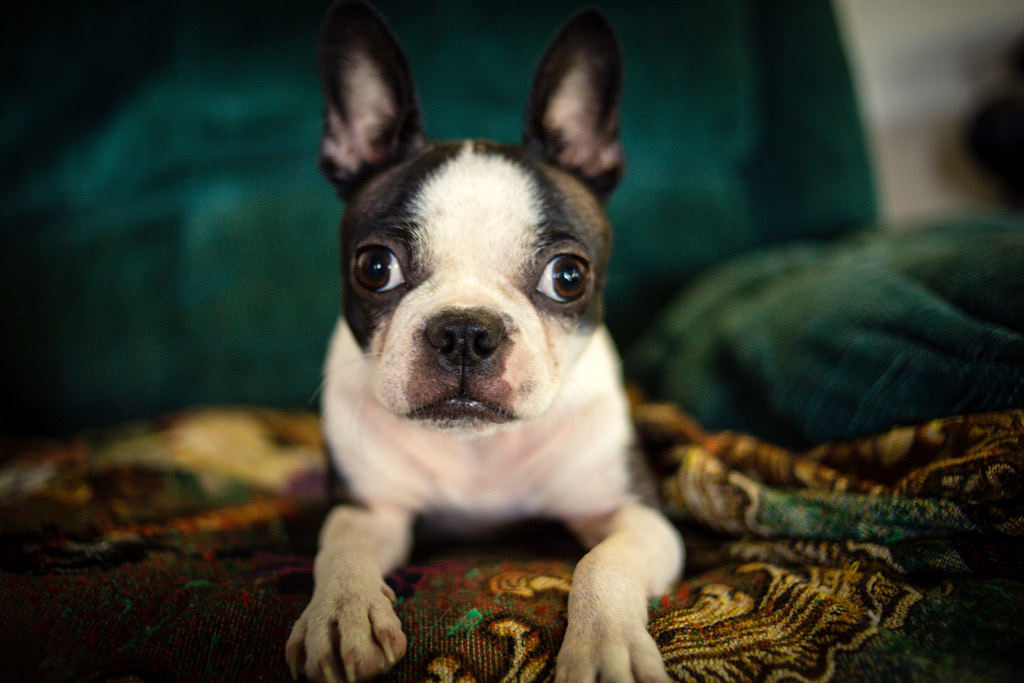
You might have heard that socializing your Boston Terrier puppy is very important and has a huge impact on your dog’s behaviour.
This sounds like a reasonable thing to do, but how do you actually put this into practice? What does dog socialization even mean?
If you’ve ever wondered or thought about this, then good news… you are not alone and you are in the right place! 🙂
Let me show you how to socialize your Boston Terrier puppy in 8 steps. (If you have an adult rescue BT, these steps are also applicable).
Boston Terrier Socialization
First of all, let’s see what socialization means. If you already understand the basics, you can choose to skip to the next point. 😉
Puppies are not born with social skills, just like children. They need to live and interact with their family (canine and/or human) to learn!
Socialization, in simple terms, means the process that a puppy must undergo to learn key life skills to ensure a happy and confident behaviour in the pup’s environment. And also being able to communicate effectively within her social group.
What does that mean?
This means your Boston Terrier puppy is comfortable around new people, pets and animals, and various places because you have exposed her to these experiences in a positive manner.
Socialization Period
The American Veterinary Society of Animal Behavior has noted that the first three months of a puppy’s life is the most important time for socialization. So…
The first 14 to 16 weeks of your puppy’s life can be considered to be your dog’s socialization period.
From birth up until 8 weeks old, Boston Terriers will be with their mom and littermates. Usually, dog breeders start socializing the pups they are raising before they get adopted.
So, socializing and training your pup will (& should) start the moment she walks through your front door.
Read also: Boston Terrier Growth Stages and Puppy Development Chart.
However, socialization is not just for puppies – you should continue the social exposure throughout a dog’s life.
If you’ve adopted an older Boston Terrier, you will want to begin socializing her the moment you bring her home too (same as you would with a puppy). It will be a more challenging experience since you need to redirect unwanted behaviour and responses to acceptable ones.
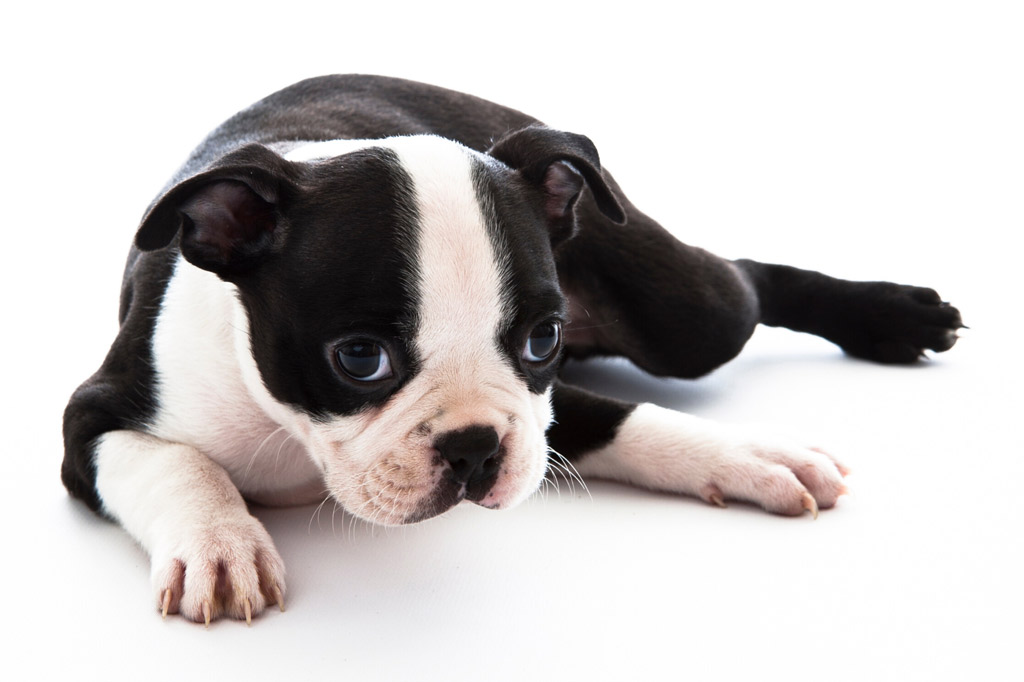
Socialization Benefits
Socializing your puppy will make a difference in how she sees the world. You don’t want her to fear new experiences, but rather welcome them.
Appropriate socialization means encouraging your pup to experience the world in a positive manner to prevent the development of fear related to new experiences.
Also, it’s about equipping your puppy with emotional resilience to cope with daily stressful situations such as being left home alone for a short period of time.
A puppy who is socialized during this period will be:
- Confident and calm.
- Able to learn new things more easily.
- Less likely to respond to new things fearfully or aggressively, preventing possible fears and phobias.
- Generally more welcomed by others.
- Less likely to develop behaviour problems since proper socialization can influence your dog’s behaviour for life.
In short, your pooch will become a great family dog!
That’s why many professionals in the field agree that socialization is one of the most important things that you can do for your puppy.
Socialization Tips
Before going through the 8 steps to socialize your Boston Terrier, use these 6 tips to make the most out of socialization:
- Be in charge of the socialization process. You should begin to introduce your Boston Terrier to new people, places, objects and situations, but only when you can control the experience.
- Pay attention to your dog’s reactions. Always keep an eye on your dog, especially to see how she reacts. Also, pay attention to your own body language, since dogs are able to read it very accurately, i.e., you should stay calm too.
- Pair rewards with exposures to make good associations. Give your dog lots of positive reinforcement like praises, petting and treats to encourage her confidence towards new experiences. Also, you can use food rewards to associate fearful situations with something tasty!
- Practise socialization gradually. You will want to take steps to gradually introduce your Boston Terrier to her new family, environment and lifestyle.
- Understand your dog’s temperament. If you want to avoid dangerous and embarrassing situations, make sure you know how your dog will react before exposing her to a situation where you can lose control over her. If your dog is too reactive to other dogs, taking her to a park full of dogs is rushing up the process.
- Don’t force socialization. If your dog is fearful of a situation or had a bad experience in the past, you should follow a desensitization process first rather than expose her to her fears directly. Also, if your dog is more of a loner and she’s not attracted to crowds and other dogs, respect her wishes.
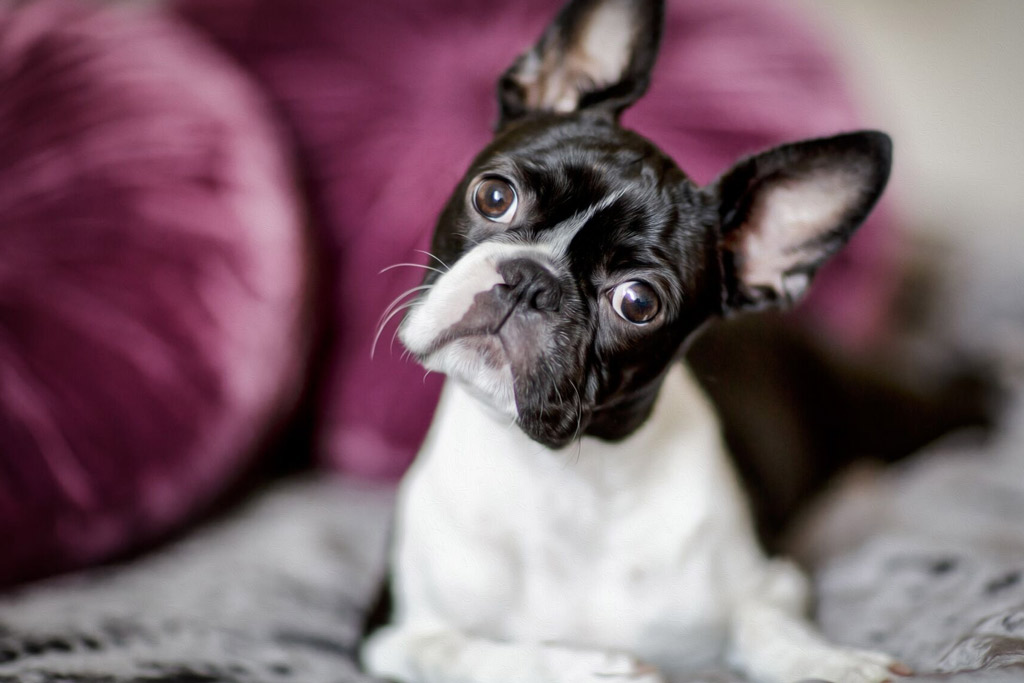
Boston Terrier Socialization In 8 Steps
Here’s how to socialize your puppy (or adult Boston Terrier) in 8 steps:
#1 – Start Early
There’s a window for socializing your pup (16 weeks old), so I would recommend starting from the first day that your Boston Terrier puppy arrives in her/your new home.
The difficulty is that puppies “should” have all their vaccinations before stepping outside the house (this is to protect her physical health). However, this delays the whole socialization process in detriment of your pup’s mental and behavioural health.
The middle ground?
Your Boston pup could have at least one set of vaccines and be parasite free before taking socialization outdoors and attending training classes, daycare, etc. In the meantime keeping up to date with age-appropriate vaccinations.
For pups that come from a breeder…
Find out if the breeder you choose does any socialization exercises while the pups are still with their mother. A good breeder will expose the pups to different people, surfaces, sounds, materials, etc. while the pups are under his or her care.
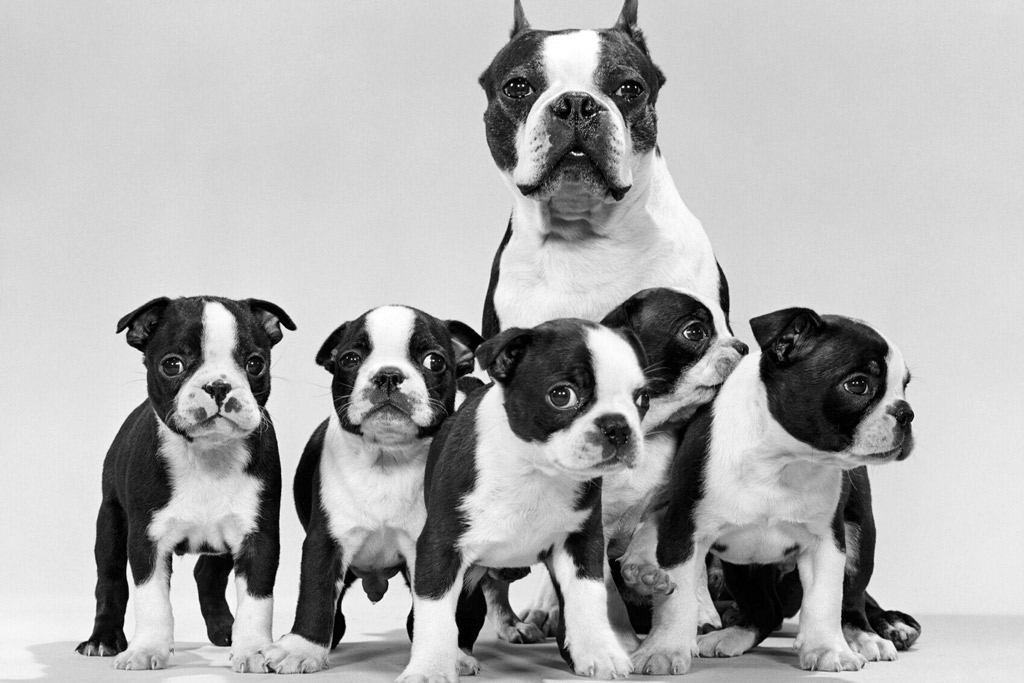
#2 – Take It Slow But Be Consistent
Follow your pup’s pace and be at a distance that your pooch feels safe. Your puppy should be the one to initiate each approach to something new (sometimes with your encouragement) and be allowed to retreat when needed to feel safe.
You can tell that your Boston is anxious or overwhelmed if:
- Your pooch is clingy.
- The ears are back.
- The tail is between the legs.
- Your dog keeps licking her lips.
- She is hiding.
Allow your pooch to back off from that situation and then let her calm down a bit. Petting her at this point will probably reinforce the fear response, so instead… once she’s calm, redirect the attention to something fun, like a game.
Remember that forcing socialization will only backfire, creating a fearful or aggressive response from your dog.
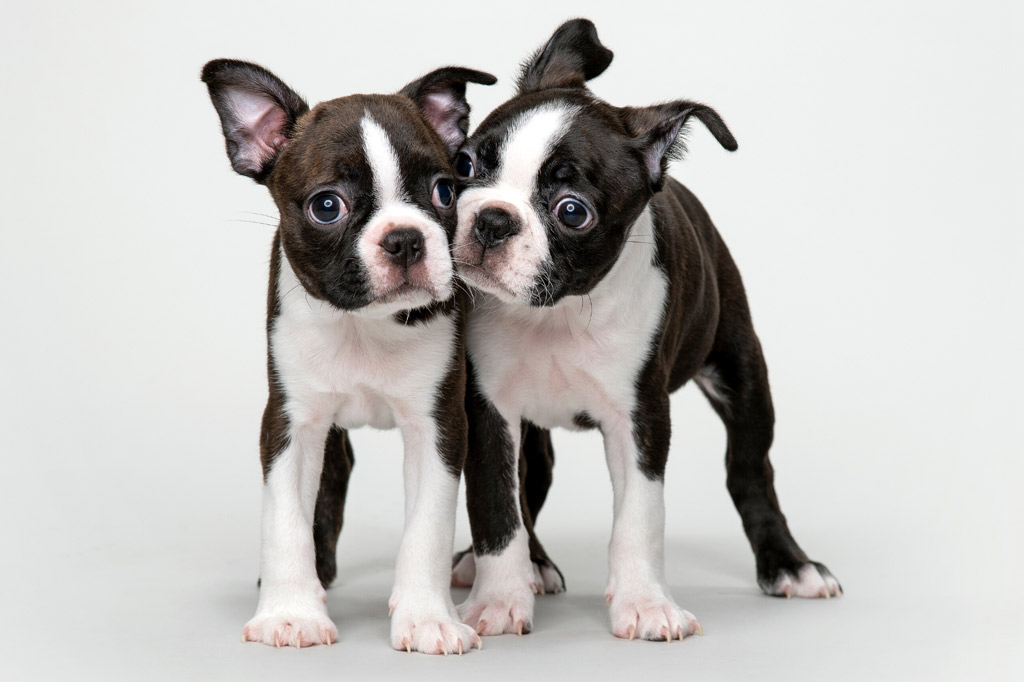
#3 – Meet Different People
The easiest way to get exposed to different people is to go for a walk around your neighbourhood.
You can ask your neighbours to say hello to your pup and let her get close so she can smell them. By doing this, your pup will learn that humans are safe to be around.
Also, you can invite friends and family to your home and get your pooch introduced. This is a great opportunity to teach her how to greet people and reinforce her calm attitude whilst humans are having a meal.
Meet and greet some more!!! The wider the range of people your pup meets during her first weeks, the better. However, always allow your pooch to retreat if she’s feeling tired or overwhelmed with the attention.
What if your pup is shy?
Play a game and involve some of the visitors. Make sure you have some treats at hand!
And if your pooch is scared?
You may want your pup to associate that particular situation with something positive, like a treat. If she is worried about the children she sees running across the street, it helps if the sight of the children makes dehydrated chicken suddenly appears.
Refer to the checklist below for ideas with meeting people!
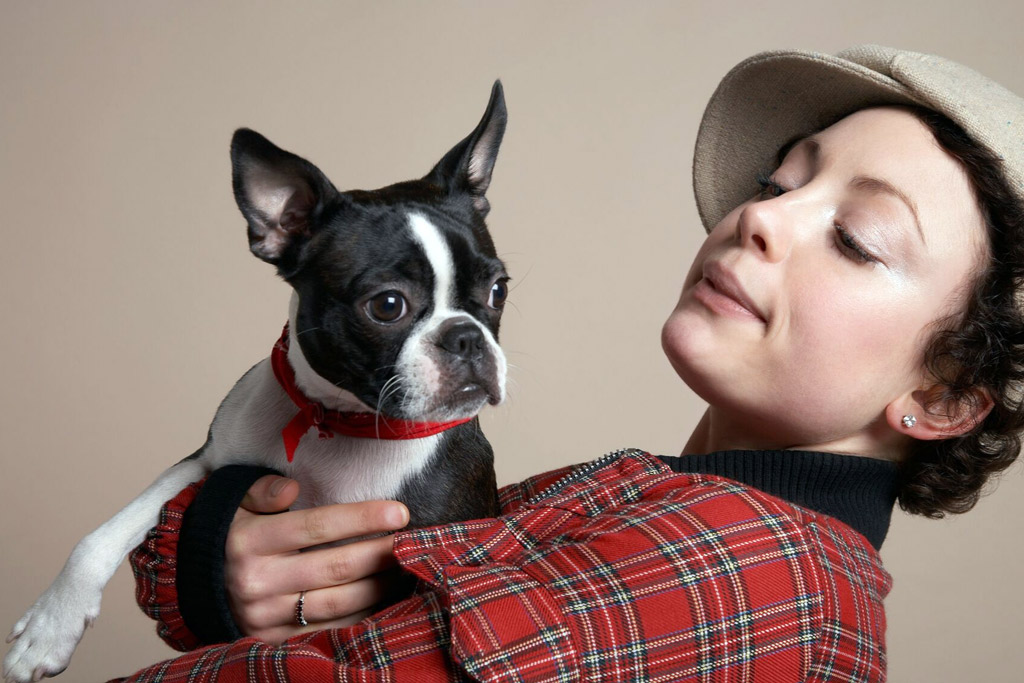
#4 – Meet Other Dogs
As soon as your vet vaccinates your puppy, you can safely expose her to other dogs.
You could invite friends who have dogs over for some playtime. This allows your pooch to meet other dogs in a controlled and safe environment.
However, it’s not enough for your pup to play with other dogs in your home only. For an appropriate socialization practice, Boston Terriers need to learn that there are many different kinds of dogs out there and that most can be friendly.
So, you can allow your Boston to meet and greet dogs during the daily walks, as long as it’s fine with the other dog owner. But make sure that is safe too.
You could make a comment like “My pup is still learning to meet other dogs. Is yours OK playing with UNFAMILIAR dogs and PUPPIES?”
During dog introductions, both dogs should be on a leash. This will allow you to control the situation and be able to remove your dog from it if necessary. Be careful not to get tangled, especially if using a long or retractable leash! (this is something I really struggled with that!) 🙁
Pay attention to your dog’s behaviour and reactions when sniffing and playing with others. Positive dog play means that:
- Both dogs are having fun.
- No one looks anxious.
- There is plenty of “give and take” with lots of curved body language and signals, such as “play bows” and exaggerated pouncing.
- There may be wrestling, growling, play-biting, etc.
If you are not sure if your puppy is having fun, do a “consent test.” I.e., gently remove your pup and see if your pup goes to seek the other one out again.
If so, they are probably OK. Otherwise, it’s time to find another playmate for a little while, or even permanently.
This doesn’t mean that the other dog is awful though! It could be that your pup was overly aroused and the other dog didn’t feel the same. Also, it could mean that the dogs’ play styles are not compatible at this stage.
When meeting different dogs, your pup learns how to communicate effectively with other dogs, how to play and where the limits are (nipping and rough play).
Puppies that don’t get socialized at an early age won’t know how to act around other dogs. That’s why they can be fearful, play too roughly or show aggressiveness.
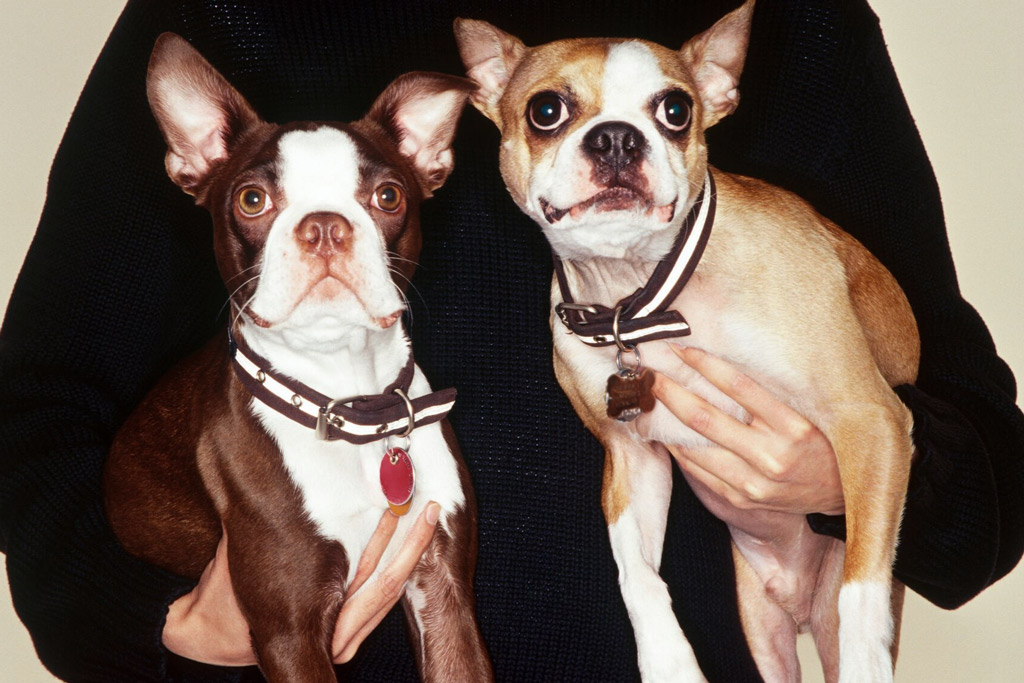
#5 – Experience Diverse Places and Situations
There are many places and situations that you could expose your Boston Terrier to. Refer to the checklist below for a thorough list and feel free to add your own!
New and different experiences will allow her to get used to the world without fear or anxiety.
On one side, you want your pup to get used to places that you frequently go to like the vet, the park, a friend’s house, etc.
On the other side, you want her to get used to being handled i.e. touched. She will be more comfortable when you must give her medication or clip her nails. Also, acclimating puppies to being handled or hugged makes a difference since, for instance, children tend to hug dogs, and most dogs don’t naturally like being hugged.
Insider Tip: Pair experiencing these new situations with a nice treat or a game. This helps to make sure that your Boston has happy experiences in these places, and so accepts them as part of her life and nothing unusual or scary.
What if you encounter resistance?
If your pup doesn’t like her paws being touched, for example, try a brief touch followed by a lick of peanut butter.
However, if she doesn’t take the food, that’s an indicator that you should back off. Allow her to get back to a comfortable state and later on, follow up by lowering the intensity of the exposure with more distance or less pressure.
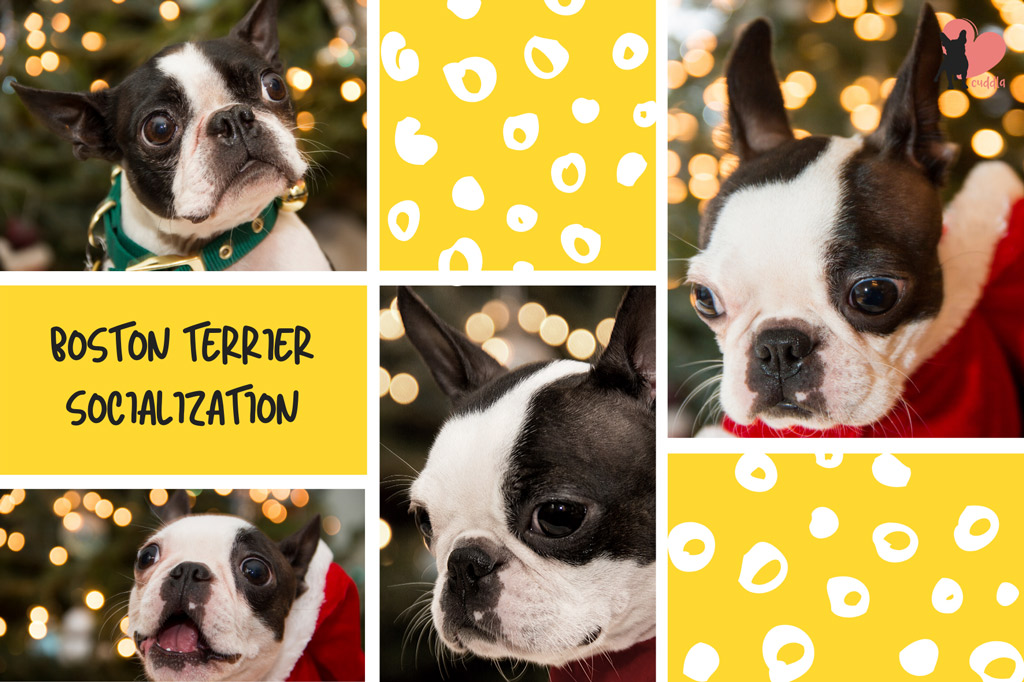
#6 – Normalize Regular Noises
Next, your puppy should also be exposed to specific objects in her environment that make noises, like the infamous vacuum cleaner.
Also, outdoor noises like thunder and fireworks are good examples to put into practice.
You probably want to reward your puppy for ignoring them and not interacting with them. (i.e., barking at them).
Your breeder may likely have already started using a playlist or app to get the pups used to different sounds that may not be found in their immediate environment (fireworks, traffic, etc). This is a great exercise to continue to promote noise desensitisation.
You should start playing the noises very quietly at mealtimes or game times, when your puppy is relaxed, and slowly build up the volume.
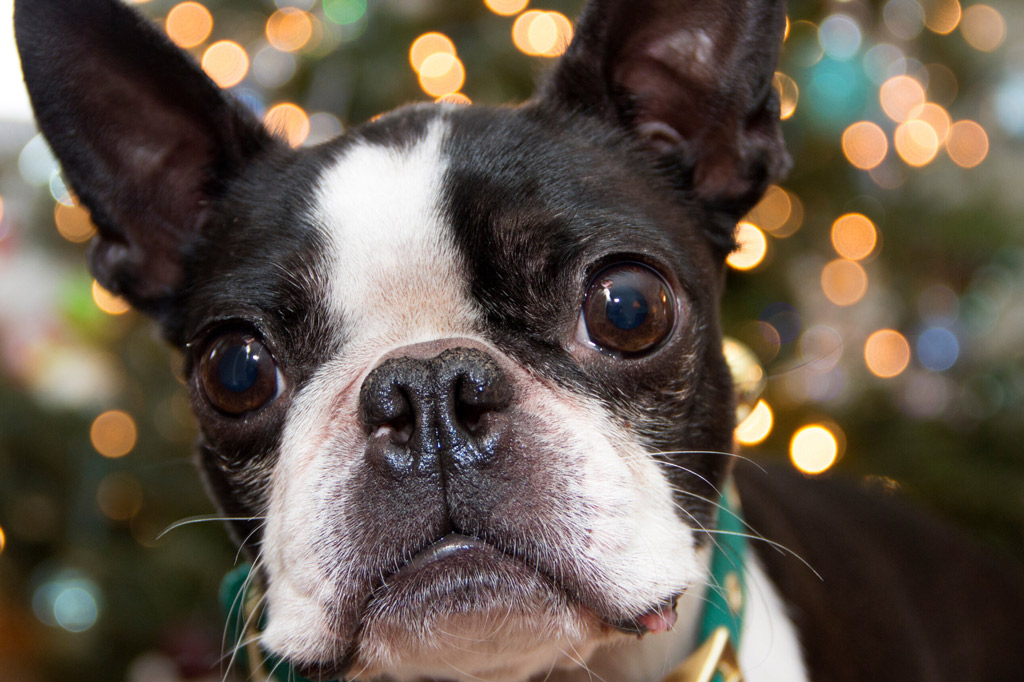
#7 – Train For Alone Time
Your dog needs human contact and reassurance, but it is also important that she learns that part of her new life includes being left alone for short periods of time.
You can use a crate, a playpen or baby/pet gates (all available on Amazon) to separate her from you gradually. This is when crate training comes in handy.
Initially, your puppy should still be able to see you and be reassured that you are there. Step by step, she will learn that she’s safe by herself and that you will always come back.
You can start with 5-minute sessions and build up to 20 minutes.
- At first stay at home, by your dog’s side.
- Then, just out of your dog’s sight.
- And gradually step out of the house.
Pair this separation with a positive experience such as eating her dinner or an interactive toy. Use my dog toy finder, for a complete range of toy options and what they are good for.
Insider Tip: Reward your pooch during the training process to encourage her to stay calm when alone and for her to know that she’s being a good girl!
Read also: Can a Boston Terrier Be Left Alone? For How Long?
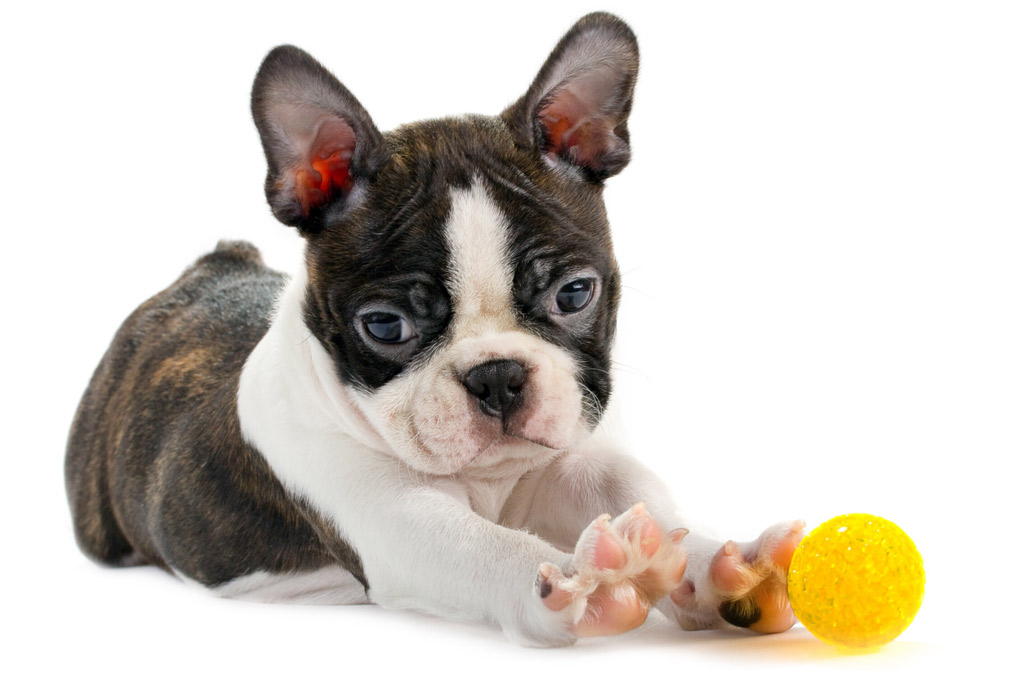
#8 – Train For Quiet Time
Your pup also needs to learn to be relaxed and settled down in your presence.
Boston Terriers learn and thrive on positive interactions, so praise your dog for being calm, no matter the event.
This can be for greetings, when other members of the family arrive (including children), for instance, and your pup keeps all four paws on the floor! Remember that jumping should be completely ignored.
Also, reward your dog when she’s quiet in her bed playing with one of her interactive toys. Remember that by rewarding this behaviour you are encouraging its repetition!
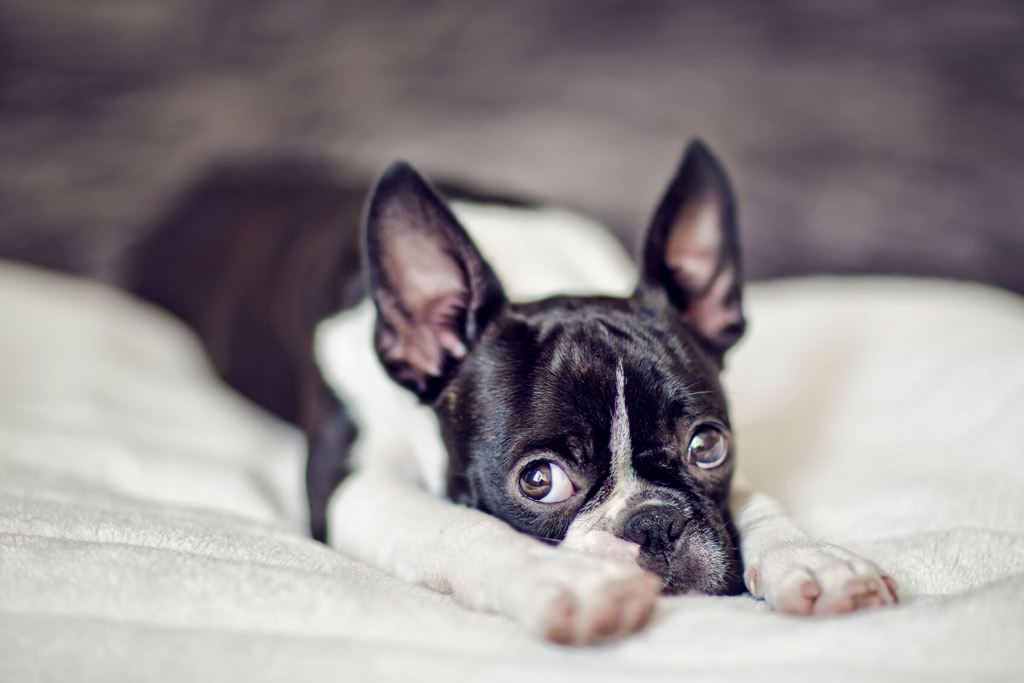
Don’t Forget…
That may have been a lot to take-in especially in one sitting, but the most important this is this:
You are a proud Boston Terrier parent – don’t forget that! You have something special and every day you can look into those gorgeous eyes and see that life is indeed better with your pup.
Getting your BT social is definitely a top priority for better life quality, but the goal isn’t to be perfect! Most of the socialization steps and tips will probably come naturally to you and you might already find that you’re doing most of them.
If there was something that made you go “oooh, that’s interesting”, make a note or highlight of it and you’ll be golden. 🙂
Boston Terrier Socialization Checklist
Here’s a thorough checklist of specific socialisation opportunities for your puppy:
#1 – People
You want to introduce your puppy to a variety of people of different sexes, ages, ethnicities, and with a variety of clothing styles.
- Adults:
- Elderly people.
- People with disabilities.
- The postman/woman.
- Cyclist and joggers.
- People playing football and other sports.
- Children:
- Babies.
- Babies in pushchairs.
- Toddlers.
- Children.
- Children playing and running.
- Teenagers.
- People carrying bags.
- People wearing hats, jewellery, helmets, sunglasses, glasses, etc.
- People being loud, arguing, shouting, and laughing.
- Crowds of people.
#2 – Interaction and Handling
You want to make your puppy comfortable and trust you with you touching, handling and grooming her:
- Holding your puppy.
- Touching her paws and checking in-between her pads.
- Touching her ears.
- Touching her tail.
- Touching her legs and belly.
- Touching her mouth and teeth.
- Putting her collar on and taking it off.
- Putting her harness on and taking it off.
- Clipping her nails.
- Brushing her teeth.
- Cleaning her eyes and nose wrinkles.
- Brushing her coat.
- Cleaning her ears.
- Etc.
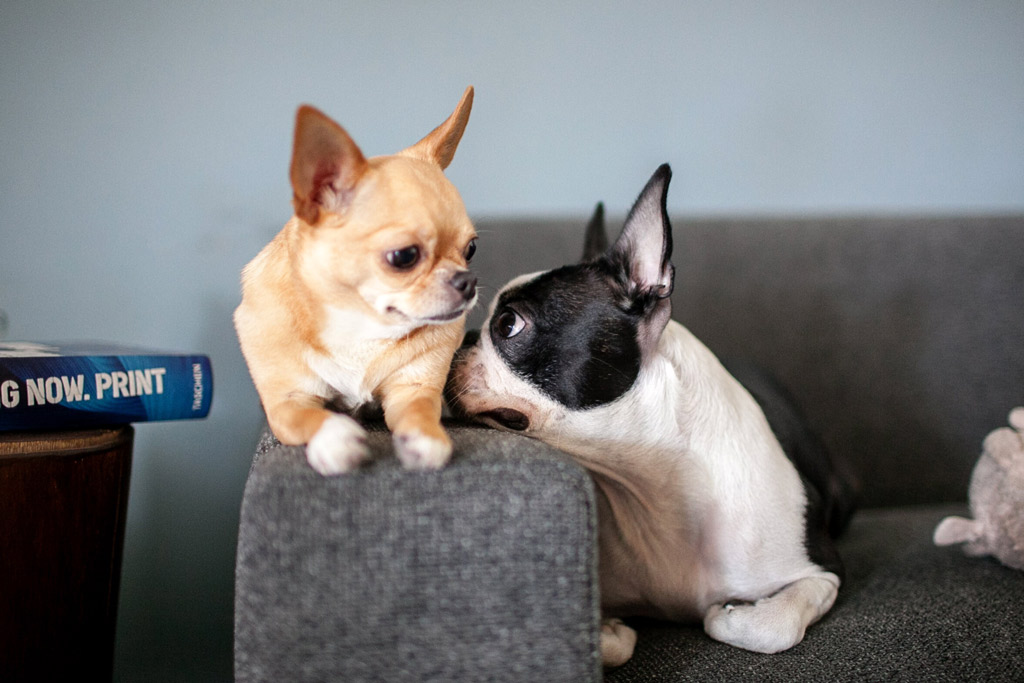
# 3 – Animals
You want your pup to meet a variety of animals and pets of different ages and species:
- Other house pets that you may have.
- Dogs (of a variety of different sizes, ages, colours and breeds).
- Cats.
- Any other animals that will form part of her life or that she may encounter, such as:
- Horses.
- Sheep.
- Cows.
- Ducks.
- Chickens.
- Other livestock.
- Small furry pets or animals (rabbits, guinea pigs, hamsters, squirrels etc.).
#4 – Places and Environments
You want to expose your pup to different environments and let her explore places that are likely to be visited often:
- Your home: different rooms in the house, including different types of flooring.
- Your garden.
- A park.
- Quiet and busy roads.
- The car itself, later on, a car ride.
- Public transport: railway stations, trains, bus stops, etc.
- Schools (if permitted).
- Vet practice.
- The Groomers.
- Daycare, sitter or boarding facility.
- Pet shop.
- Water and swimming.
- Being surrounded by nature: forest, mountains, lake, beach, etc.
- Any other environment that you think your dog may encounter in the future.
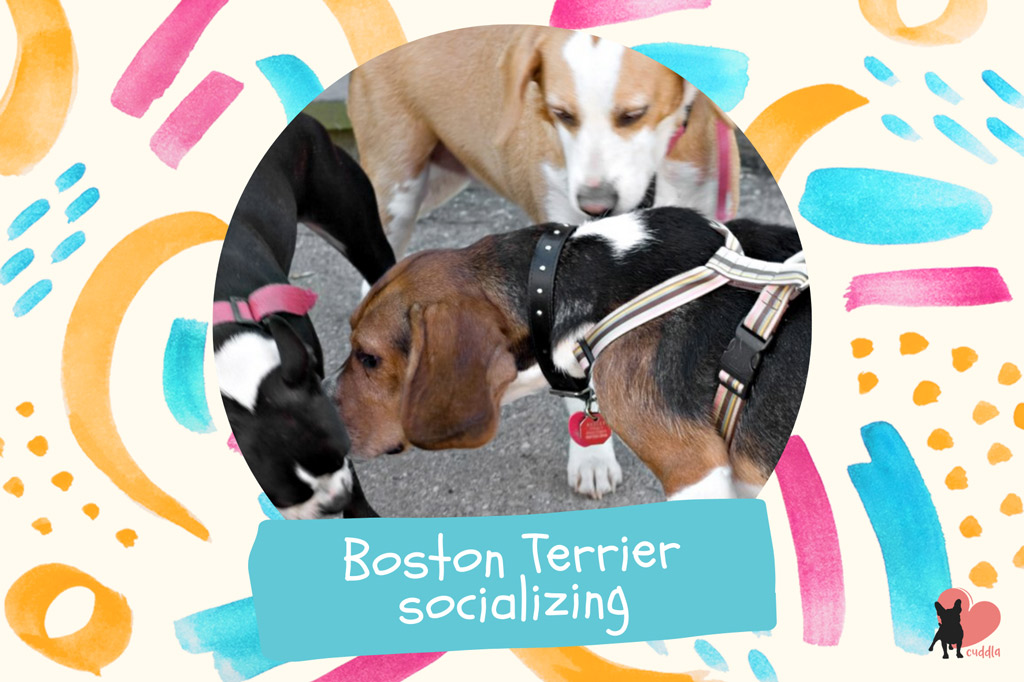
#5 – Noises
Get your puppy familiar with everyday noises and also some unexpected ones too:
- Noises at home:
- Doorbell.
- Vacuum cleaner.
- Hairdryer.
- Telephone and mobile phone.
- TV, music and radio.
- Kettle.
- Coffee grinder (we found it to be too loud for some pooches!)
- Etc.
- Garden noises:
- Lawnmower.
- Birds.
- Outside noise:
- Sirens.
- Car speeding.
- Car Horns.
- Fireworks.
- Thunderstorms.
- Fairs, markets and festivals.

What’s Next
After going through this, you may feel socialization feels a lot like training… and you’re not wrong.
Some dog parents and owners would likely also call this behaviour training; there’s no incorrect term here as the idea is more or less the same.
If you’re just getting started with training or would like to quickly address the 3 most common behaviour problems:
- Potty training.
- Leash pulling.
- Biting/nipping.
Then I may be able to help with that. Click here to visit our Dog Training Essentials, where you will get a 3-part mini audio series + the everyday resource used by a well-known dog trainer.
You can also get this using the button below. Happy socializing and training!
